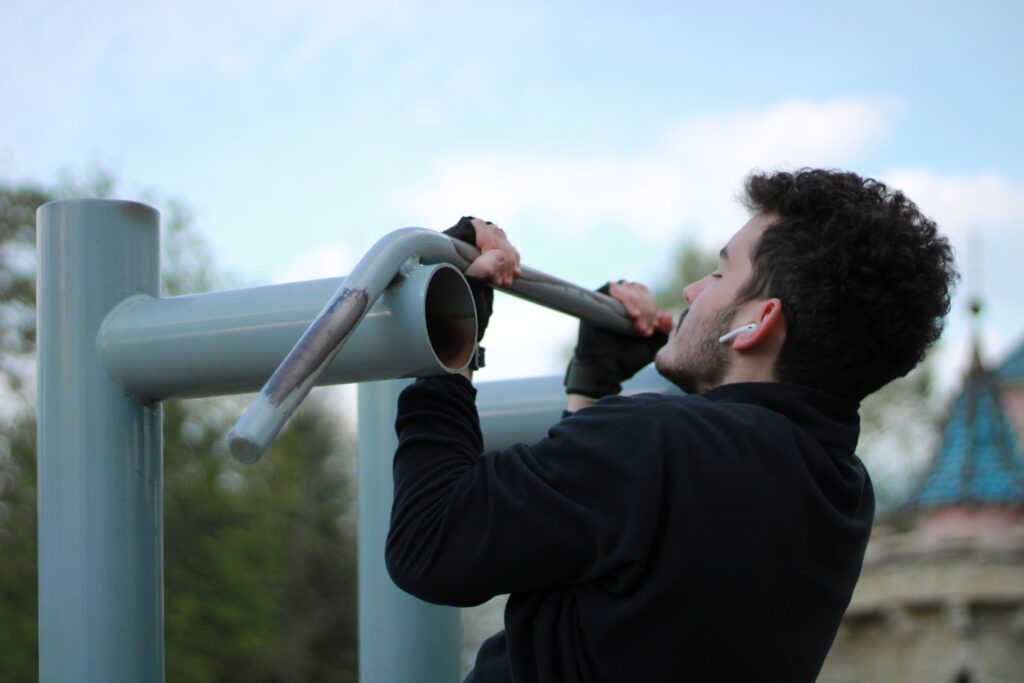Introduction
Calisthenics, a form of bodyweight exercise, offers a versatile and accessible way to enhance strength, build muscle, and improve overall fitness. Within the world of calisthenics, there are four main training types, each with its own unique benefits and exercise variations. Whether you’re aiming for impressive feats of strength, focusing on muscle and power development, following a military-style regimen, or pursuing general health and fitness goals, understanding these different types of calisthenics will help you tailor your training to achieve optimal results.
1. Freestyle or Gymnastic Style Calisthenics

Freestyle or gymnastic-style also known as “playground calisthenics,” or “street workout” involves captivating movements that impress observers. This style requires significant training and expertise due to its complexity and risk. It often involves working with a coach in a safe training environment to perform advanced moves such as 360 muscle-ups, toe touch pull-ups, switchblades, flagpoles, and more. While some freestyle calisthenics tricks can be practiced independently, it is crucial to prioritize safety and seek professional guidance to perfect your technique.(read more)
2. Calisthenics for Muscle and Power

Calisthenics for muscle and power involves a strategic approach similar to bodybuilding. The focus is on intelligent training to increase strength, build muscle, and enhance overall power. Many bodybuilders incorporate this type of workout into their routines to supplement weight training. As you develop strength, you can perform impressive moves like muscle-ups, clapping push-ups, and clapping dips. However, it’s important to remember that these feats of strength are just a small part of your training. Most workouts consist of common moves, variations, and training to fail to stimulate muscle growth.
3. Military-Style Calisthenics
Military-style prioritizes strength and endurance, simulating the training methods used by soldiers. This style requires minimal equipment and emphasizes high repetitions in selected exercises. Common exercises include push-ups, pull-ups, chin-ups, planks, sit-ups, crunches, and squats. Military-style workouts often involve circuit training with minimal rest between exercises and reps. Building stamina and reducing breaks are key goals in this type of training. Complementing the workouts with running further enhances endurance and overall body strength.
4. General Health and Fitness Calisthenics

General health and fitness type of training aim to improve overall fitness without a specific focus on gaining muscle or mastering specific skills. These workouts can be used for weight loss, enhancing cardiovascular health, or increasing general fitness levels. Fitness apps and follow-along video HIT workouts often fall under this category. Typically, these workouts consist of short routines with intervals of rest between exercises. They are effective for improving overall fitness and increasing energy levels, but they do not lead to significant muscle growth or skill mastery.
Benefits Of Bodyweight Training

1. Strength Development:
Bodyweight training is an effective method for building strength throughout your entire body. Exercises such as push-ups, squats, lunges, planks, and pull-ups engage multiple muscle groups simultaneously, challenging both your upper and lower body. These exercises promote functional strength, as they mimic natural movements and improve overall stability and balance. By progressively increasing the intensity and difficulty of bodyweight exercises, you can continue to challenge your muscles and achieve impressive strength gains.
2. Flexibility and Mobility:
Flexibility is a vital component of overall fitness and plays a crucial role in injury prevention. Bodyweight training incorporates dynamic movements that promote flexibility and mobility. Exercises like yoga flows, lunges with rotations, and bodyweight squats with overhead reaches improve the range of motion and increase joint flexibility. Regular practice of bodyweight exercises can enhance your overall flexibility, allowing for better performance in other physical activities and reducing the risk of injuries.(read more)
3. Convenience and Accessibility:
One of the greatest advantages of bodyweight training is its convenience and accessibility. You can perform bodyweight exercises anytime, anywhere, as they require minimal to no equipment. Whether you’re at home, in a park, or traveling, you can engage in a full-body workout using your body as resistance. This accessibility makes bodyweight training an ideal choice for individuals with busy schedules, limited resources, or those who prefer exercising in the comfort of their own space.
4. Weight Management and Cardiovascular Health:
Bodyweight exercises offer an excellent way to manage weight and improve cardiovascular health. High-intensity bodyweight workouts, such as circuit training or interval training, elevate your heart rate, providing an effective cardiovascular workout. The combination of strength-building exercises and cardio bursts boosts your metabolism, helping you burn calories and fat more efficiently. Regular bodyweight training can contribute to weight management, improve heart health, and increase overall stamina and endurance.(read more)
Conclusion
Understanding the four main types of bodyweight training allows you to optimize your workout to meet your specific goals. Whether you are drawn to the impressive movements of freestyle calisthenics, the strategic muscle-building approach, military-style training, or general health and fitness routines, incorporating calisthenics into your fitness regimen can provide numerous benefits.
Remember to prioritize safety, seek guidance when necessary, and listen to your body as you embark on your calisthenics journey. By embracing this versatile form of exercise, you can enhance your strength, build muscle, and achieve a healthier, fitter version of yourself.






